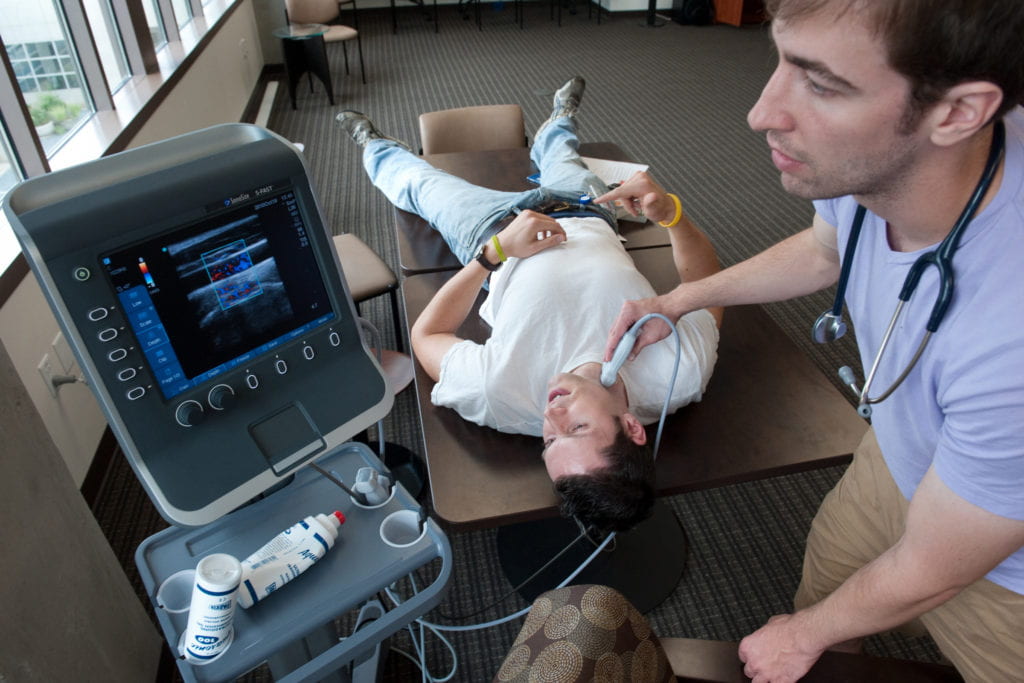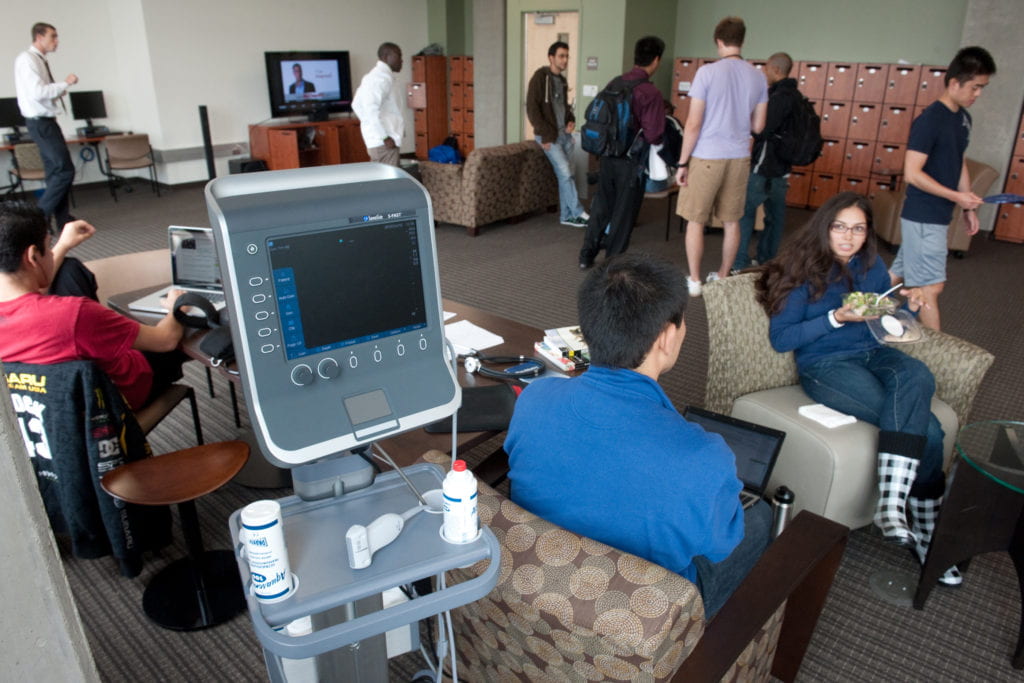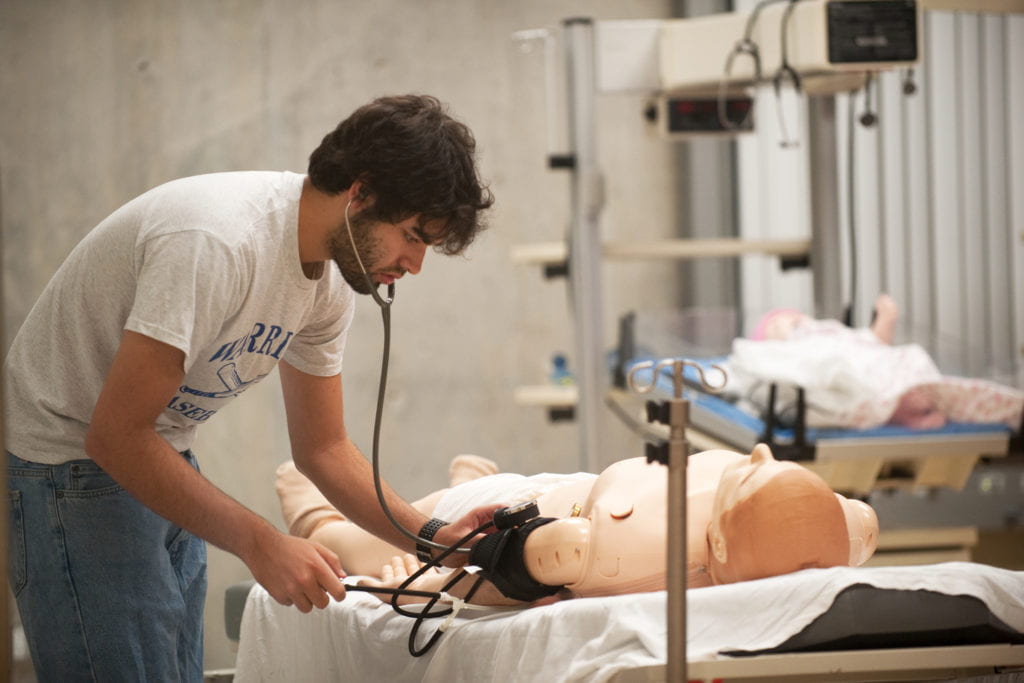Revolutionizing the education of doctors
By providing students with technological devices such as iPads and portable ultrasounds, UC Irvine School of Medicine is revolutionizing the way healthcare is taught. For the future doctors, such tools could one day be as standard as the stethoscope.
On her first day as a UC Irvine medical student, Sarah Rooney received an Apple iPad.
Not just any ordinary iPad — this one came loaded with all of the books, notes, presentations and videos she needs for her first year of medical school. UCI’s School of Medicine was first in the nation to provide the tablet computers to all new students as an innovative way to present the challenging first-year curriculum.
“The iPad consolidates all of our coursework in one place,” Rooney says. “It puts us light years ahead of what other students are doing.”
UCI medical students are using iPads and other high-tech tools as part of the school’s iMedEd Initiative, which is changing how tomorrow’s doctors are being trained — and the future of healthcare.
“What we’re doing will be the standard at all medical schools,” says Dr. Ralph V. Clayman, dean of medicine. “By using these new technologies, we’re going to train the very best, skilled and knowledgeable physicians in the country.”
Rooney already sees a dramatic difference between her education and her husband Kevin’s. A third-year UCI medical student, he spent the first two years studying to be a doctor the traditional way: through the classic lecturer-passive listener model.
While he lugged around heavy texts and thick notebooks, his wife downloads podcasts and PowerPoint presentations of her lectures, detailed notes and illustrations that she shares with classmates during small-group study sessions.
“He’s a little bit envious of us,” Rooney says. “A lot of my classmates like having all of our resources available on our iPads. Since handheld computers will be used by doctors in the future, using them now prepares us in ways that aren’t available to medical students at other schools.”
Fellow first-year student Molly Baker is learning human anatomy using a unique portable ultrasound machine that lets her see inside the body in ways unavailable to medical students before. One device was even placed in the Medical Education Building student lounge, allowing Baker and her classmates to practice on each other and hone their skills.
“It’s exciting and fun to use the ultrasound,” Baker says. “It adds a lot to what we’re learning in class.”
SonoSite, the devices’ manufacturer, has partnered to make UCI the exclusive medical school to integrate ultrasound into all four years of medical training. The devices are already used in emergency rooms as diagnostic tools.
“We’re giving students the tools they need to practice modern medicine,” says Dr. Chris Fox, director of instructional ultrasound and assistant professor of emergency medicine. “This is teaching for the future. When you provide students with the opportunity to actually see the anatomy — organs, blood vessels, bone and muscle — that’s how they really learn. By the time they graduate, our students’ ability to diagnose disease will be unsurpassed by any conventional means of practicing medicine.”
Clayman believes that technologies like tablet computing and portable ultrasound will become a standard part of a physician’s “black bag” and lead to new proactive and personalized medicine.
While giving an exam, he explains, a physician using portable ultrasound can get detailed information from inside a patient’s body — such as blood flow though the heart and carotid artery — and prescribe preventative measures to mitigate a potential health risk. And the same doctor can easily and quickly track medical records and health data on an iPad when meeting with patients.
“That’s the big difference these tools can make,” Clayman adds. “And our students are on the crest of this new patient-care wave.”
As part of its iMedEd Initiative, the medical school offers one of the most advanced clinical skills centers in the country. The center features interactive medical instructional technology as well as 10 clinical examination and interview rooms with video cameras linked to an audio-visual center, a clinical skills laboratory, and a simulation room with three full-body simulators — lifelike mannequins that allow students to perform procedures prior to treating real patients.
“Most medical schools will be going in this direction,” Baker says of the iMedEd Initiative. “It’ll be tough for those who don’t. I feel fortunate.”
Dr. Warren Wiechmann, director of instructional technologies and developer of the iPad program, says the next steps will be to digitalize the entire four-year curriculum and develop new applications for the iPad format while getting feedback from students to make sure the technologies meet their expectations.
Already, other medical schools are showing an interest.
“It’s been challenging to triage all of the calls coming in, asking us how we’re doing this,” he says. “We’re getting a lot of attention, and there are a lot of eyes on us to see if this works.”






